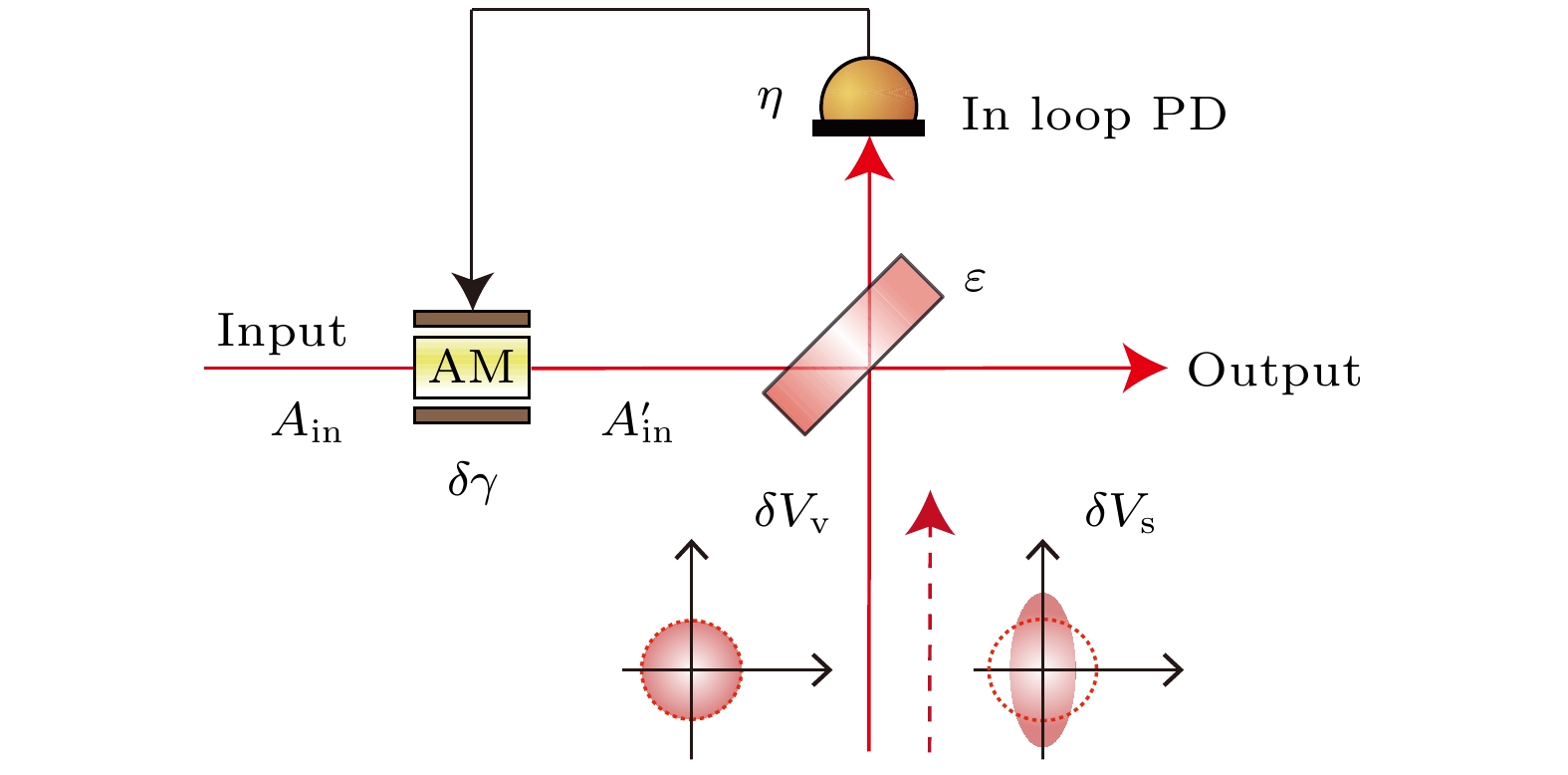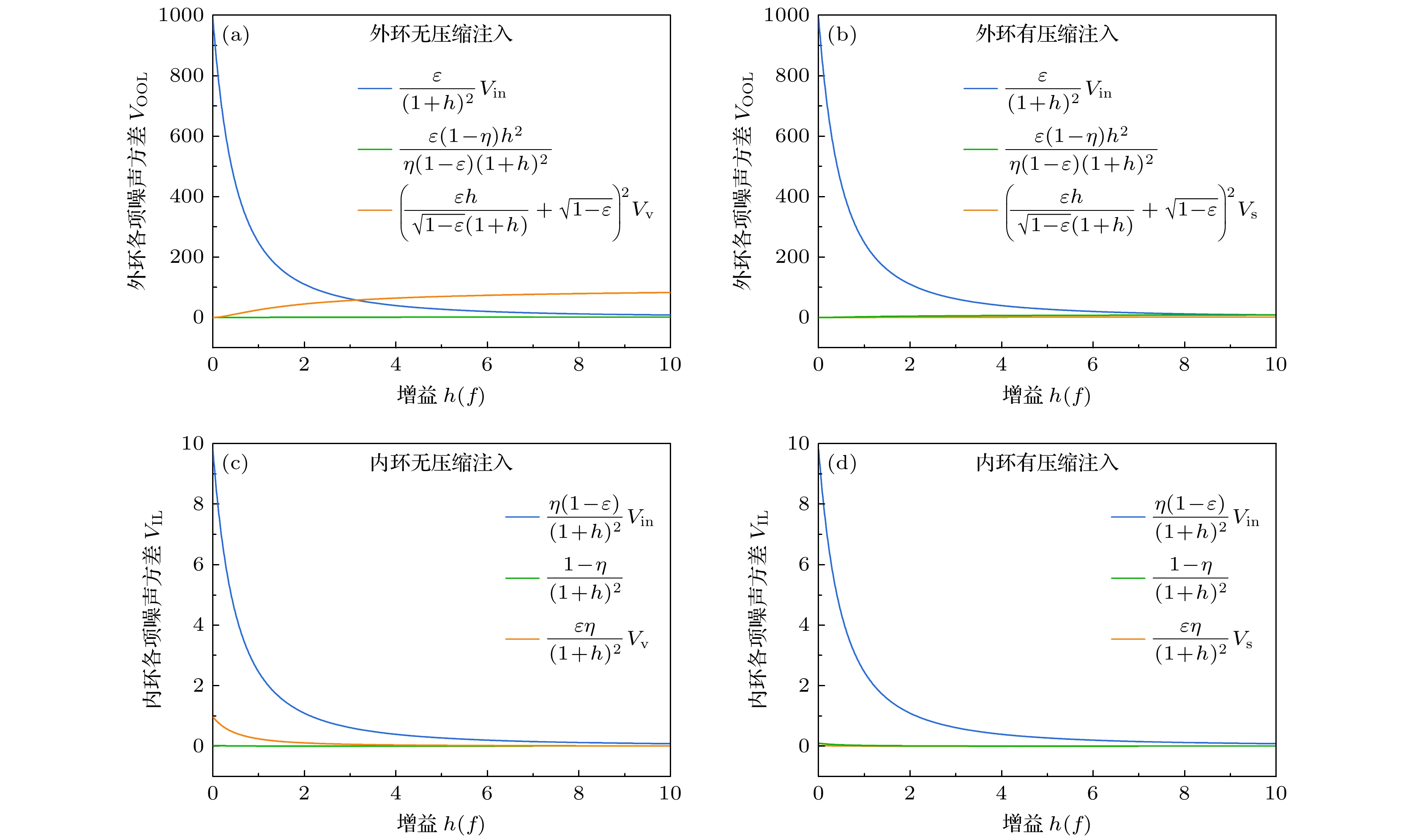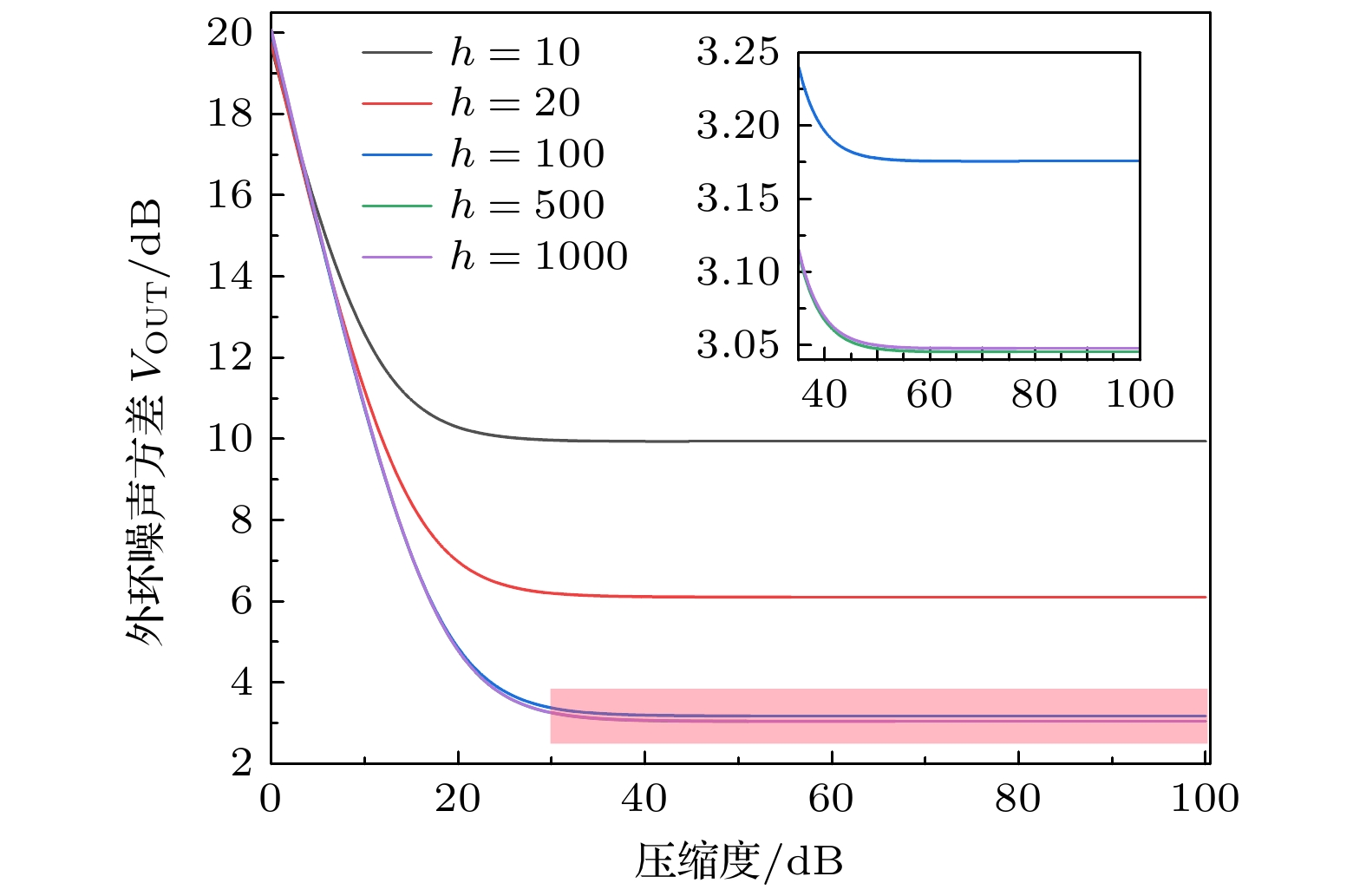-
激光光源的噪声直接影响精密测量系统的精度和灵敏度, 特别是在引力波探测和生物成像等高精度应用中. 尽管经典反馈控制技术能有效地抑制强度噪声, 但其降噪水平受到经典噪声极限的限制. 本研究提出一种结合量子压缩光与经典反馈控制技术的新方法, 旨在进一步降低系统中的强度噪声, 突破经典反馈控制技术的抑噪瓶颈. 通过引入正交振幅压缩态光场, 在理论上建立了压缩光辅助的反馈控制系统, 理论分析了反馈增益和压缩度对噪声抑制的影响, 并与经典方案进行对比. 理论分析结果表明, 压缩光的引入显著地提高了噪声抑制水平, 接近散粒噪声极限, 从而大幅提升系统的灵敏度. 该方法为在不增加激光功率的情况下实现更低噪声水平提供了新的量子控制手段, 对精密测量技术的发展具有重要意义.This research focuses on advanced noise suppression technologies for high-precision measurement systems, particularly addressing the limitations of classical noise reducing approaches. The noise level of laser sources is a crucial factor that directly affects the measurement sensitivity in applications such as gravitational wave detection and biomedical imaging. Classical feedback control technologies are effective but often encounter a bottleneck resulting from the classical noise suppression limits. To cope with these challenges, a novel method integrating quantum squeezed light with classical feedback control systems to reduce intensity noise is proposed in this work. By employing an amplitude-squeezed light field, a quantum-enhanced feedback control model is developed, thereby theoretically examining the influence of both the feedback loop gain and the degree of squeezing on the noise suppression performance. The results show that the injection of squeezed light significantly reduces the intensity noise, approaching the shot noise limit (SNL), thereby improving the system sensitivity beyond the classical noise reduction boundaries. Specifically, –10 dB squeezed state injection into the feedback system yields an additional noise suppression of approximately 8.97 dB, exceeding what is achievable using classical feedback alone. This demonstrates that the potential of the proposed method can enhance measurement precision close to the quantum noise limits without increasing the laser power. The analysis highlights the asymmetric noise suppression effects between the inner feedback loop and outer feedback loop. Although the outer loop benefits significantly from the squeezed light injection and achieves noise levels that are unattainable by classical feedback methods, the inner loop shows relatively minor improvements. This asymmetry is attributed to the inherent characteristics of quantum squeezing and the limitations of the feedback loop design. Further investigation into the individual noise components reveals that the primary contributors to the intensity noise include input noise, photodetector noise, and beam splitter-induced vacuum fluctuations. The injection of squeezed light effectively mitigates these vacuum fluctuations, which are typically a major noise source in high-precision laser systems. Theoretical research results show that the use of squeezed light in feedback control systems can effectively enhance noise suppression, equivalent to a nine fold increase in detected optical power, without the physical drawbacks of increasing laser power such as thermal noise. In conclusion, this study provides a theoretical validation of combining quantum squeezed states with classical feedback control to exceed classical noise suppression limits. The integration of a –10 dB squeezed state demonstrates a significant noise reduction, showing that this hybrid approach could revolutionize noise management in precision measurement applications. The results pave the way for further exploring quantum-enhanced control technologies in fields such as gravitational wave detection, quantum communication, and advanced optical sensing, providing a pathway for improving sensitivity and noise suppression without increasing additional power requirements.
-
Keywords:
- precision measurement /
- squeezed state /
- noise suppression /
- feedback control
[1] The LIGO Scientific Collaboration 2015 Classical Quantum Gravity 32 074001
 Google Scholar
Google Scholar
[2] Acernese F, Agathos M, Agatsuma K, Aisa D, Allemandou N, Allocca A, Meidam J 2014 Classical Quantum Gravity 32 024001
 Google Scholar
Google Scholar
[3] LIGO Scientific and Virgo Collaborations 2016 Phys. Rev. Lett. 116 061102
 Google Scholar
Google Scholar
[4] LIGO Scientific and Virgo Collaborations 2017 Phys. Rev. Lett. 119 141101
 Google Scholar
Google Scholar
[5] Taylor M A, Janousek J, Daria V, Knittel J, Hage B, Bachor H A, Bowen W P 2013 Nat. Photonics 7 229
 Google Scholar
Google Scholar
[6] Casacio C A, Madsen L S, Terrasson A, Waleed M, Barnscheidt K, Hage B, Bowen W P 2021 Nature 594 201
 Google Scholar
Google Scholar
[7] Brito R, Ghosh S, Barausse E, Berti E, Cardoso V, Dvorkin I, Klein A, Pani P 2017 Phys. Rev. D 96 064050
 Google Scholar
Google Scholar
[8] Armano M, Audley H, Baird J, Binetruy P, Born M, Bortoluzzi D, Zweifel P 2018 Phys. Rev. Lett. 120 061101
 Google Scholar
Google Scholar
[9] Kaufer S, Kasprzack M, Frolov V, Willke B 2017 Classical Quantum Gravity 34 145001
 Google Scholar
Google Scholar
[10] Seifert F, Kwee P, Heurs M, Willke B, Danzmann K 2006 Opt. Lett. 31 2000
 Google Scholar
Google Scholar
[11] Kwee P, Willke B, Danzmann K 2009 Opt. Lett. 34 2912
 Google Scholar
Google Scholar
[12] Junker J, Oppermann P, Willke B 2017 Opt. Lett. 42 755
 Google Scholar
Google Scholar
[13] 王俊萍, 张文慧, 李瑞鑫, 田龙, 王雅君, 郑耀辉 2020 69 234204
 Google Scholar
Google Scholar
Wang J P, Zhang W H, Li R X, Tian L, Wang Y J, Zheng Y H 2020 Acta Phys. Sin. 69 234204
 Google Scholar
Google Scholar
[14] 王雅君, 王俊萍, 张文慧, 李瑞鑫, 田龙, 郑耀辉 2021 70 204202
 Google Scholar
Google Scholar
Wang Y J, Wang J P, Zhang W H, Li R X, Tian L, Zheng Y H 2021 Acta Phys. Sin. 70 204202
 Google Scholar
Google Scholar
[15] Yamamoto Y, Haus H A 1986 Rev. Mod. Phys. 58 1001
 Google Scholar
Google Scholar
[16] Xiao M, Wu L A, Kimble H J 1987 Phys. Rev. Lett. 59 27
 Google Scholar
Google Scholar
[17] Zhao J, Guiraud G, Pierre C, Floissat F, Casanova A, Hreibi A, Chaibi W, Traynoer N, Boullet J, Santarelli G 2018 Appl. Phys. B 124 1
 Google Scholar
Google Scholar
[18] Paschotta R, Fiedler K, Kürz P, Mlynek J 1994 Appl. Phys. B 58 117
 Google Scholar
Google Scholar
[19] Haus H A, Yamamoto Y. 1984 Phys. Rev. A 29 1268
 Google Scholar
Google Scholar
[20] Zhang J, Ma H L, Xie C D, Peng K C 2003 Appl. Opt. 42 1068
 Google Scholar
Google Scholar
[21] 王在渊, 王洁浩, 李宇航, 柳强 2023 72 054205
 Google Scholar
Google Scholar
Wang Z Y, Wang J H, Li Y H, Liu Q 2023 Acta Phys. Sin. 72 054205
 Google Scholar
Google Scholar
[22] 王雅君, 高丽, 张晓莉, 郑耀辉 2020 红外与激光工程 49 20201073
 Google Scholar
Google Scholar
Wang Y J, Gao L, Zhang X L, Zheng Y H 2020 Infrared Laser Eng. 49 20201073
 Google Scholar
Google Scholar
[23] Kwee P, Willke B, Danzmann K 2008 Opt. Lett. 33 1509
 Google Scholar
Google Scholar
[24] Kwee P, Willke B, Danzmann K 2011 Opt. Lett. 36 3563
 Google Scholar
Google Scholar
[25] Kaufer S, Willke B 2019 Opt. Lett. 44 1916
 Google Scholar
Google Scholar
[26] 姚德民, 郭光灿 1988 37 463
 Google Scholar
Google Scholar
Yao D M, Guo G C 1988 Acta Phys. Sin. 37 463
 Google Scholar
Google Scholar
[27] Vahlbruch H, Wilken D, Mehmet M, Willke B 2018 Phys. Rev. Lett. 121 173601
 Google Scholar
Google Scholar
[28] Eberle T, Steinlechner S, Bauchrowitz J, Händchen V, Vahlbruch H, Mehmet M, Müller-Ebhardt H, Schnabel R 2010 Phys. Rev. Lett. 104 251102
 Google Scholar
Google Scholar
[29] Liu F, Zhou Y Y, Yu J, Guo J L, Wu Y, Xiao S X, Wei D, Zhang Y, Jia X J, Xiao M 2017 Appl. Phys. Lett. 110 021106
 Google Scholar
Google Scholar
[30] Wu L A, Kimble H J, Hall J L, Wu H F 1986 Phys. Rev. Lett. 57 2520
 Google Scholar
Google Scholar
[31] Schneider K, Lang M, Mlynek J, Schiller S 1998 Opt. Express 2 59
 Google Scholar
Google Scholar
[32] Vahlbruch H, Chelkowski S, Danzmann K, Schnabel R 2007 New J. Phys. 9 371
 Google Scholar
Google Scholar
[33] Vahlbruch H, Mehmet M, Danzmann K, Schnabel R 2016 Phys. Rev. Lett. 117 110801
 Google Scholar
Google Scholar
[34] Kleybolte L, Gewecke P, Sawadsky A, Korobko M, Schnabel R 2020 Phys. Rev. Lett. 125 213601
 Google Scholar
Google Scholar
[35] Meylahn F, Willke B, Vahlbruch H 2022 Phys. Rev. Lett. 129 121103
 Google Scholar
Google Scholar
[36] Yang W H, Jin X L, Yu X D, Zheng Y H, Peng K C 2017 Opt. Express 25 24262
 Google Scholar
Google Scholar
[37] Zhang W H, Wang J R, Zheng Y H, Wang Y J, Peng K C 2019 Appl. Phys. Lett. 115 171105
 Google Scholar
Google Scholar
[38] 潘建伟 2024 73 010301
 Google Scholar
Google Scholar
Pan J W 2024 Acta Phys. Sin 73 010301
 Google Scholar
Google Scholar
[39] Clerk A A, Devoret M H, Girvin S M, Marquardt F, Schoelkopf R. J 2010 Rev. Mod. Phys. 82 1155
 Google Scholar
Google Scholar
[40] Aspelmeyer M, Kippenberg T J, Marquardt F 2014 Rev. Mod. Phys. 86 1391
 Google Scholar
Google Scholar
-
-
[1] The LIGO Scientific Collaboration 2015 Classical Quantum Gravity 32 074001
 Google Scholar
Google Scholar
[2] Acernese F, Agathos M, Agatsuma K, Aisa D, Allemandou N, Allocca A, Meidam J 2014 Classical Quantum Gravity 32 024001
 Google Scholar
Google Scholar
[3] LIGO Scientific and Virgo Collaborations 2016 Phys. Rev. Lett. 116 061102
 Google Scholar
Google Scholar
[4] LIGO Scientific and Virgo Collaborations 2017 Phys. Rev. Lett. 119 141101
 Google Scholar
Google Scholar
[5] Taylor M A, Janousek J, Daria V, Knittel J, Hage B, Bachor H A, Bowen W P 2013 Nat. Photonics 7 229
 Google Scholar
Google Scholar
[6] Casacio C A, Madsen L S, Terrasson A, Waleed M, Barnscheidt K, Hage B, Bowen W P 2021 Nature 594 201
 Google Scholar
Google Scholar
[7] Brito R, Ghosh S, Barausse E, Berti E, Cardoso V, Dvorkin I, Klein A, Pani P 2017 Phys. Rev. D 96 064050
 Google Scholar
Google Scholar
[8] Armano M, Audley H, Baird J, Binetruy P, Born M, Bortoluzzi D, Zweifel P 2018 Phys. Rev. Lett. 120 061101
 Google Scholar
Google Scholar
[9] Kaufer S, Kasprzack M, Frolov V, Willke B 2017 Classical Quantum Gravity 34 145001
 Google Scholar
Google Scholar
[10] Seifert F, Kwee P, Heurs M, Willke B, Danzmann K 2006 Opt. Lett. 31 2000
 Google Scholar
Google Scholar
[11] Kwee P, Willke B, Danzmann K 2009 Opt. Lett. 34 2912
 Google Scholar
Google Scholar
[12] Junker J, Oppermann P, Willke B 2017 Opt. Lett. 42 755
 Google Scholar
Google Scholar
[13] 王俊萍, 张文慧, 李瑞鑫, 田龙, 王雅君, 郑耀辉 2020 69 234204
 Google Scholar
Google Scholar
Wang J P, Zhang W H, Li R X, Tian L, Wang Y J, Zheng Y H 2020 Acta Phys. Sin. 69 234204
 Google Scholar
Google Scholar
[14] 王雅君, 王俊萍, 张文慧, 李瑞鑫, 田龙, 郑耀辉 2021 70 204202
 Google Scholar
Google Scholar
Wang Y J, Wang J P, Zhang W H, Li R X, Tian L, Zheng Y H 2021 Acta Phys. Sin. 70 204202
 Google Scholar
Google Scholar
[15] Yamamoto Y, Haus H A 1986 Rev. Mod. Phys. 58 1001
 Google Scholar
Google Scholar
[16] Xiao M, Wu L A, Kimble H J 1987 Phys. Rev. Lett. 59 27
 Google Scholar
Google Scholar
[17] Zhao J, Guiraud G, Pierre C, Floissat F, Casanova A, Hreibi A, Chaibi W, Traynoer N, Boullet J, Santarelli G 2018 Appl. Phys. B 124 1
 Google Scholar
Google Scholar
[18] Paschotta R, Fiedler K, Kürz P, Mlynek J 1994 Appl. Phys. B 58 117
 Google Scholar
Google Scholar
[19] Haus H A, Yamamoto Y. 1984 Phys. Rev. A 29 1268
 Google Scholar
Google Scholar
[20] Zhang J, Ma H L, Xie C D, Peng K C 2003 Appl. Opt. 42 1068
 Google Scholar
Google Scholar
[21] 王在渊, 王洁浩, 李宇航, 柳强 2023 72 054205
 Google Scholar
Google Scholar
Wang Z Y, Wang J H, Li Y H, Liu Q 2023 Acta Phys. Sin. 72 054205
 Google Scholar
Google Scholar
[22] 王雅君, 高丽, 张晓莉, 郑耀辉 2020 红外与激光工程 49 20201073
 Google Scholar
Google Scholar
Wang Y J, Gao L, Zhang X L, Zheng Y H 2020 Infrared Laser Eng. 49 20201073
 Google Scholar
Google Scholar
[23] Kwee P, Willke B, Danzmann K 2008 Opt. Lett. 33 1509
 Google Scholar
Google Scholar
[24] Kwee P, Willke B, Danzmann K 2011 Opt. Lett. 36 3563
 Google Scholar
Google Scholar
[25] Kaufer S, Willke B 2019 Opt. Lett. 44 1916
 Google Scholar
Google Scholar
[26] 姚德民, 郭光灿 1988 37 463
 Google Scholar
Google Scholar
Yao D M, Guo G C 1988 Acta Phys. Sin. 37 463
 Google Scholar
Google Scholar
[27] Vahlbruch H, Wilken D, Mehmet M, Willke B 2018 Phys. Rev. Lett. 121 173601
 Google Scholar
Google Scholar
[28] Eberle T, Steinlechner S, Bauchrowitz J, Händchen V, Vahlbruch H, Mehmet M, Müller-Ebhardt H, Schnabel R 2010 Phys. Rev. Lett. 104 251102
 Google Scholar
Google Scholar
[29] Liu F, Zhou Y Y, Yu J, Guo J L, Wu Y, Xiao S X, Wei D, Zhang Y, Jia X J, Xiao M 2017 Appl. Phys. Lett. 110 021106
 Google Scholar
Google Scholar
[30] Wu L A, Kimble H J, Hall J L, Wu H F 1986 Phys. Rev. Lett. 57 2520
 Google Scholar
Google Scholar
[31] Schneider K, Lang M, Mlynek J, Schiller S 1998 Opt. Express 2 59
 Google Scholar
Google Scholar
[32] Vahlbruch H, Chelkowski S, Danzmann K, Schnabel R 2007 New J. Phys. 9 371
 Google Scholar
Google Scholar
[33] Vahlbruch H, Mehmet M, Danzmann K, Schnabel R 2016 Phys. Rev. Lett. 117 110801
 Google Scholar
Google Scholar
[34] Kleybolte L, Gewecke P, Sawadsky A, Korobko M, Schnabel R 2020 Phys. Rev. Lett. 125 213601
 Google Scholar
Google Scholar
[35] Meylahn F, Willke B, Vahlbruch H 2022 Phys. Rev. Lett. 129 121103
 Google Scholar
Google Scholar
[36] Yang W H, Jin X L, Yu X D, Zheng Y H, Peng K C 2017 Opt. Express 25 24262
 Google Scholar
Google Scholar
[37] Zhang W H, Wang J R, Zheng Y H, Wang Y J, Peng K C 2019 Appl. Phys. Lett. 115 171105
 Google Scholar
Google Scholar
[38] 潘建伟 2024 73 010301
 Google Scholar
Google Scholar
Pan J W 2024 Acta Phys. Sin 73 010301
 Google Scholar
Google Scholar
[39] Clerk A A, Devoret M H, Girvin S M, Marquardt F, Schoelkopf R. J 2010 Rev. Mod. Phys. 82 1155
 Google Scholar
Google Scholar
[40] Aspelmeyer M, Kippenberg T J, Marquardt F 2014 Rev. Mod. Phys. 86 1391
 Google Scholar
Google Scholar
计量
- 文章访问数: 711
- PDF下载量: 39
- 被引次数: 0














 下载:
下载:



